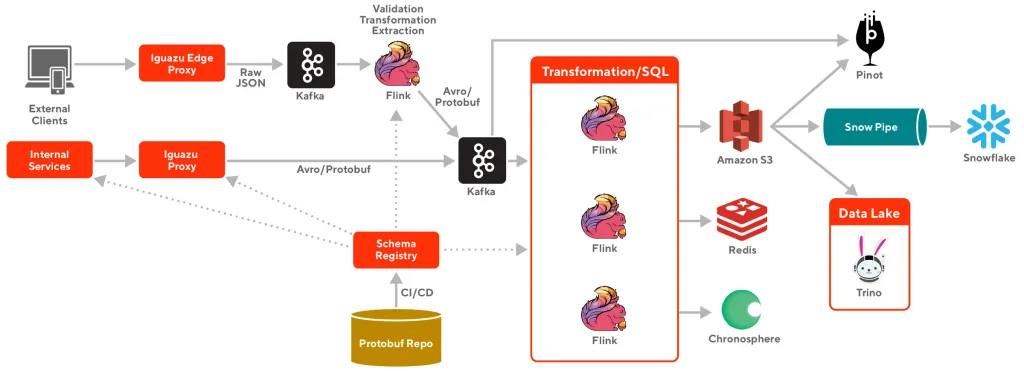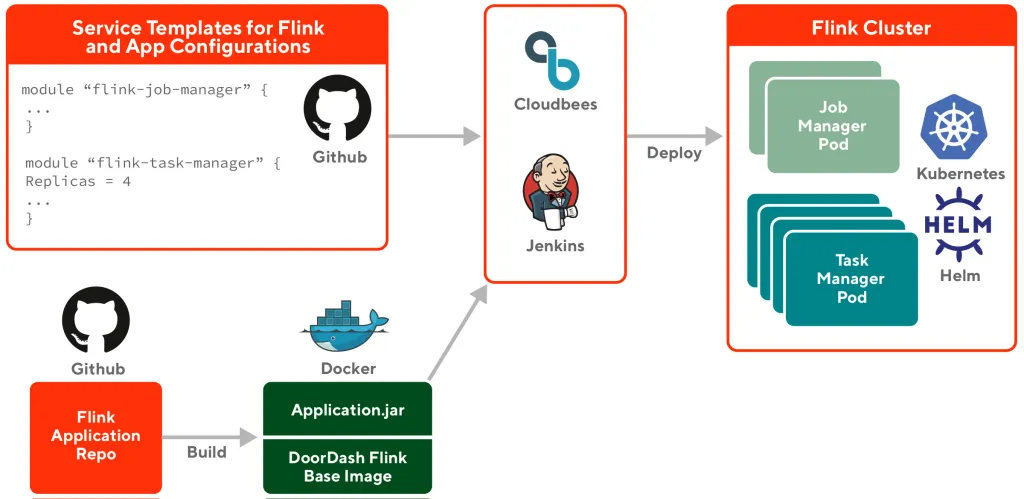Building Scalable Real Time Event Processing with Kafka and Flink
这篇笔记来自于DoorDash Engineering blog
Legacy System
早期DoorDash的数据平台如下, 使用Snowflake作为data warehouse

但这种方式有一些问题
- Cost inefficient: 需要构建多个相似的pipeline,成本比较高
- Observability: 将多个种类的data transport, messaging/queueing系统放在一起,对于observability比较困难
结果就是high data latency, significant cost, and operational overhead
Introducing Iguazu
Iguazu是DoorDash自研的real time event processing system, 解决了以下问题
- Heterogeneous data sources and destinations: 能够从各个不同的source(monolithic web application, microservices and mobile/web devices)获取数据,并且发送到不同的destination
- Easily accessible: 方便各个team使用data stream并且可以customize processing logic
- End-to-end schema enforcement and schema evolution
- Scalable, fault-tolerant, and easy to operator for a small team
将高度依赖AWS和第三方vendor的战略转向使用,定制和整合开源系统,最终的架构如下

Simplify and optimize event producing
使用Kafka作为pub/sub system
Leveraging and enhancing Kafka Rest Proxy
使用Kafka最方便的方法应该是创建Kafka client,但是这样做有几个问题
- 如果每个team都要configure Kafka connection的话会有重复工作,而且他们也不一定熟悉Kafka配置
- 不能为Kafka producer提供uniform and optimized configuration
- 在mobile和web application链接Kafka不现实
因此使用了Confluent Kafka Rest Proxy,它提供了一些基本功能
- Supporting different kinds of payload formats, including JSON and binaries
- Supporting batch, which is crucial to reduce processing overhead for both client applications and Kafka brokers
- Integration with Confluent’s schema registry makes it possible to validate and convert the JSON payload with schema
在此之上,DoorDash进行了更改并加入了以下功能
- The capability to produce multiple Kafka clusters
- Asynchronous Kafka producing requests: 在message放到producer的buffer之后就马上返回,但它会导致data loss,优化方法是retry + monitor
- Pre-fetching Kafka topic metadata and producing test Kafka records as part of the Kubernetes pod readiness probe: Warm up cache and Kafka connection来避免冷启动问题
- Supporting Kafka header as port of the proxy produce request payload: 使用Kafka header来避免(de)serialization cost
optimizaing producer configuration
- 2 for replication factor, 1 for minimal in-sync replica
- 一旦partition leader收到ack就返回成功
- 50ms - 100ms for linger ms to leverage sticky partitioner
上面的操作大概将Kafka broker CPU使用率降低30 - 40%
Running Rest Proxy in Kubernetes
Event processing with different abstractions
使用Flink作为processing engine
Deployment with Helm in Kubernetes
提供基本的Flink docker支持与DoorDash其他的系统整合和发送metrics,每个Flink job作为单独的Kubernetes service使用standalone模式deploy. 使用Terraform Flink template进一步简化开发流程

Providing SQL Abstraction
sources:
- name: canary_store_order_count
type: REALTIME
compute_spec:
type: RIVIERA
riviera_spec:
kafka_sources:
- cluster: default
topic: store_timeline_events
proto_class: "com.doordash.timeline_events.StoreTimelineEvent"
sql: >-
SELECT
store_id as st,
SUM(CAST(has_store_order_confirmed_data AS INT)) as
saf_st_p20mi_order_count_sum_canary
FROM store_timeline_events
GROUP BY HOP(_time, INTERVAL '20' SECONDS,
INTERVAL '20' MINUTES),
store_id
resource_config:
number_task_manager: 2
memory: "1Gi"
cpu: "2400m"
features:
- name: canary_store_order_count
source: canary_store_order_count
materialize_spec:
sink:
- prod_canary_features
feature_ttl: 1200
metadata_spec:
description: Store Order Sum over 20 minute
Deploy Flink SQL只需要创建以上PR,之后CD pipeline会构建Flink job并且deploy
Event format, serialization, and schema validation
所有的event都有standard envelope and payload(比如creation time, source, metadata, references to schema),payload含有actual content,并且将non-schematized raw JSON blob放进event里
Internal microservice发出的event都会进行schema validation,mobile/web events则是raw json,会有另外的一套stream processing系统对其进行schema validation/transformation

使用Confluent schema registry,而且不在runtime register schema,因为
- 在有新的event发来时会产生大量的schema update requests,对schema registry造成影响
- incompatible schema change会导致update failure,进而造成runtime error
因此,DoorDash将schema registry update与CI/CD process整合在一起,PR提交的时候CI会validate schema,如果fail的话不允许merge,merge之后CD会自动register/update schema registry
Data Warehouse Integration
Snowflake仍然是DoorDash主要的data warehouse,与Snowflake的整合主要分为两步
- Flink会从Kafka获取data并且将其以Parquest file format写入S3,这一步主要是decouple ingest process from Snowflake itself, StreamingFileSink
- Data会通过Snowpipe从S3 copy到Snowflake, triggered by SQS messages
每种event都有各自的stream processing application for S3 upload and own Snowpipe
Working towards a self-serve platform
每种event在Iguazu中都有自己从Flink到Snowpipe的pipeline,这就对infra的self-serve和operation有很高的要求
一开始整个过程比较复杂,DoorDash采用Infrastructure-As-Code的原则

创建Github App来programmatically create and merge pull requests, 同时使用Cadence workflow engine来进一步加强automation
为了更进一步提供self-serve,使用Retool framework创建UI
Learnings and Future Work
- Create event processing system with a platform mindset,不要轻易被ad-hoc solutions带偏方向
- Picking the right framework, Kafka, Flink, Confluent Rest Proxy, Confluent schema registry
- Try to make system more user friendly and easy to adopt